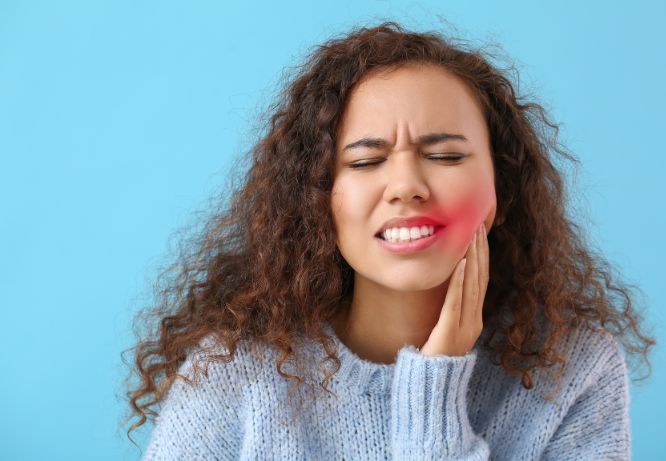
Cavity fillings are some of the most common dental procedures, meant to restore teeth from decay and further damage. However, it is not uncommon that some degree of pain or discomfort may arise after the filling. Understanding why this will happen, how to take care of it, and when you should pay a further visit to your dentist is important for easy recovery. This comprehensive guide shall look at various causes of pain following the filling of a cavity, the duration it generally lasts, and the best modes of pain management.
Pain post a Cavity filling: Understanding
Pain after a filling can be alarming if you don’t know why it is happening. These pains are, more often than not, no more than a part of the recovery process. Following are some of the common causes of the possible discomfort after a cavity filling. In this respect, consider:
Tooth Sensitivity
- Why it happens: Probably the most frequent complaint following the filling of the tooth is sensitivity. Once the decay is taken out and the filling is placed, the inside nerve of the tooth may get irritated. This could be the reason for hypersensitivity towards the variation in temperature – hot or cold food and drinks, pressure, and even sweet food.
- Duration: Sensitivity usually only lasts a few days up to a week. However, it also can take several weeks depending on how the tooth adapts to the new filling.
High Filling
- Why It Happens: This is because, if the filling is somewhat higher than the tooth structure around it, it gives you an uneven bite. This irregularity in your chewing could enable excessive pressure on the tooth being filled while you eat; hence the pain and discomfort.
- Duration: The discomfort created by a high filling will typically start right after the anesthesia has worn off. It will persist until the filling is corrected by your dentist.
Irritation of the Nerve
- Why it happens: If the decay was deep and proximate to the pulp of the tooth, where the nerve is located, then the process involved in the filling might have irritated the nerve. It will provoke inflammation and lead to pain or discomfort.
- Duration: Depending upon the case, the pain due to irritated nerves may last from several days to weeks. In severe cases where irritation to nerves is extreme, further intervention might be necessary.
Referred Pain
- Why It Occurs: Sometimes, the filled tooth gives rise to pain in the other teeth around it. This kind of pain, referred pain, almost always arises from the body’s response to the insult or stress created by the dental work.
- Duration: Referred pain is normally self-limiting and would only persist for a week.
Allergic Reaction to the Filling Material
- Why it happens: Although extremely rare, a very minute number of patients may prove allergic to the amalgam or composite resin filling material. A resultant allergic reaction can manifest as pain, itching, swelling or a rash.
- Duration: In cases of allergic reaction, painful symptoms will continue persisting until the filling material is replaced.
How long does pain take to clear after dental filling?
Pain is one symptom of discomfort that may ensue from a variety of reasons after a dental procedure. It can indeed be one symptom of this discomfort, but exactly how it will persist is due to this exact cause. Here is what you can expect.
Mild to Moderate Sensitivity: The majority of the patients have light to moderate sensitivity for several days, which can last up to one week after filling the cavity. In most instances, this can be dealt with by taking over-the-counter pain relievers and also by avoiding the triggers that may worsen the sensitivity, such as very hot, cold, or sweet food.
Persistent pain: For the pain to stop, if the pain is due to high filling or irritation of the nerve, then it may take longer. In this case, the high filling will keep on giving pain until your dentist adjusts it. On the other hand, irritation of nerves will take several weeks in order to get completely recovered.
Severe Pain: Sharp pain is not normal after a filling. The onset of sharp throbbing pains that, over time, neither subside nor worsen may indicate that something has gone wrong-an infection, for example, or additional dental work may be needed. In all these cases, reach out to your Dentist in Mt Vernon, NY at Aurora Smiles for an assessment.
Pain Management After a Cavity Filling
Pain following a filling is an annoyance, but it can be managed. Here’s how to manage discomfort or, better yet, get rid of it altogether.
Over-the-Counter Pain Relievers
- What to Use: Over-the-counter pain relievers such as ibuprofen Advil, Motrin or acetaminophen Tylenol can help to reduce inflammation and ease pain.
- How to Use: Follow dosage on the label and take the medication as needed for pain relief.
Avoid Trigger Foods and Drinks
- What to avoid: For some time immediately after the filling, avoid extreme heat or cold, or sweet food and drinks. These things increase sensitivity and create a lot of discomfort.
- What can be consumed: Anything that is not too hot or cold, like lukewarm or room temperature food and drinks; the least irritating to the tooth will be the best option.
Use desensitizing toothpaste.
- Why It Helps: Desensitizing toothpaste for sensitive teeth can help reduce sensitivity over time. Such products contain ingredients like potassium nitrate that block the pain signals from the nerve of a tooth.
- How to Use: Lightly brush your teeth with a soft-bristled toothbrush and desensitizing toothpaste, being gentle around your newly filled tooth.
Bite Adjustment
- Why It Helps: If you believe your filling is too high, or you simply think that your bite feels wrong, you will need to make an appointment with your dentist. Sometimes, the dentist may relieve the discomfort with a minor adjustment.
- When to See Your Dentist: If you have constant pain or something feels off with your bite, don’t hesitate to reach out to your Dentist in Mt Vernon NY at Aurora Smiles for an adjustment.
Ice Pack
- How It Helps: An ice pack on the outside of your cheek near the filled tooth helps reduce inflammation and numbs the area providing temporary pain relief.
- How to Use: Place a cloth between an ice pack and skin and apply it to the area for 15-20 minutes at a time.
Chew on the Other Side
- Why It Works: The sensitivity some pain and cold-sensitive patients get when they chew on their tooth with a filling can cause discomfort. Chewing on the opposite side of your mouth can give the sensitivity in the tooth with the new filling some time to heal.
- How Long to Use: Continue chewing on the opposite side until the sensitivity is gone.
When to Call Your Dentist
While slight discomfort after a filling is quite normal, some symptoms will need you to call your Dentist in Mt Vernon, NY. The following are some symptoms that should make you see a dentist:
Prolonged or worsening pain: If the pain is to persist longer than a week, advances in intensity or changes to sharp and throbbing, it may be because of an underlying complication which requires intervention.
Severe pain, especially if swelling or fever accompanies it: Severe pain accompanied by swelling or fever may indicate infection. A fever, most especially, indicates infection, and immediate attention from a dentist is strongly indicated.
Constant Bite Problems: If your bite feels off or the filling seems too high, your dentist needs to make an adjustment so you will avoid more discomfort and possible further damage to the tooth.
Allergic Reaction Symptoms: If you have any swelling, itching or a rash where the filling is located you need to contact your dentist right away and talk about your options regarding replacing the filling material.
How to Avoid Pain following Future Fillings
It isn’t possible to prevent pain after a filling at all times, but there is several things you can try to minimize the chances this will occur and to make your recovery easier as well:
Dental Filling Material of Choice
- What to Consider: One can discuss the pros and cons of different filling materials, amalgam, composite resin or porcelain with your dentist. The materials work for certain teeth or for patients who have high sensitivity.
- What We Recommend: Trust the professionals of Restorative Dentistry at Aurora Smiles serving Mt Vernon, NY to guide you through this selection.
Catch Cavities Early
- Why It Helps: Catching and treating the cavity as early as possible-before the cavity gets down to the nerve of the tooth-will help minimize pain post-filling.
- How to Stay on Top of It: Regular dental visits at Aurora Smiles will help to catch cavities at a stage where one can implement less invasive treatments.
Practice good oral hygiene
- How It Helps: If done properly, both brushing and flossing could prevent numerous cavities from ever occurring – and thus avoid fillings.
- Daily Routine: Brush your teeth with fluoride toothpaste at least twice daily, floss once a day, and visit your dentist periodically for cleaning and check-up.
Watch What You Eat
- What to Avoid: Sugary treats and drinks because they encourage tooth decay.
- What to Eat: Foods that promote good oral health, including milk products, leafy greens, and fiber-rich vegetables.
Final Words on Pain After Cavity Filling
Experiencing some pain after a cavity filling is quite normal and typically nothing to be alarmed about. Understanding the reasons behind the pain, knowing how long it usually lasts, and learning effective ways to manage or alleviate it can make your recovery process much smoother. It’s also important to recognize when it might be necessary to see a dentist for further evaluation, ensuring any issues are addressed promptly.
For expert care and management of fillings or any concerns related to restorative dental procedures, reach out to Dr. Amul Patel at Aurora Smiles, the leading Dentist in Mt. Vernon, NY. Whether it’s for a cavity filling or other restorative dental care, Dr. Amul Patel and his team are dedicated to providing high-quality care that ensures your comfort and long-term dental health.
Schedule a consultation with Dr. Amul Patel today to receive the expert care you deserve.
